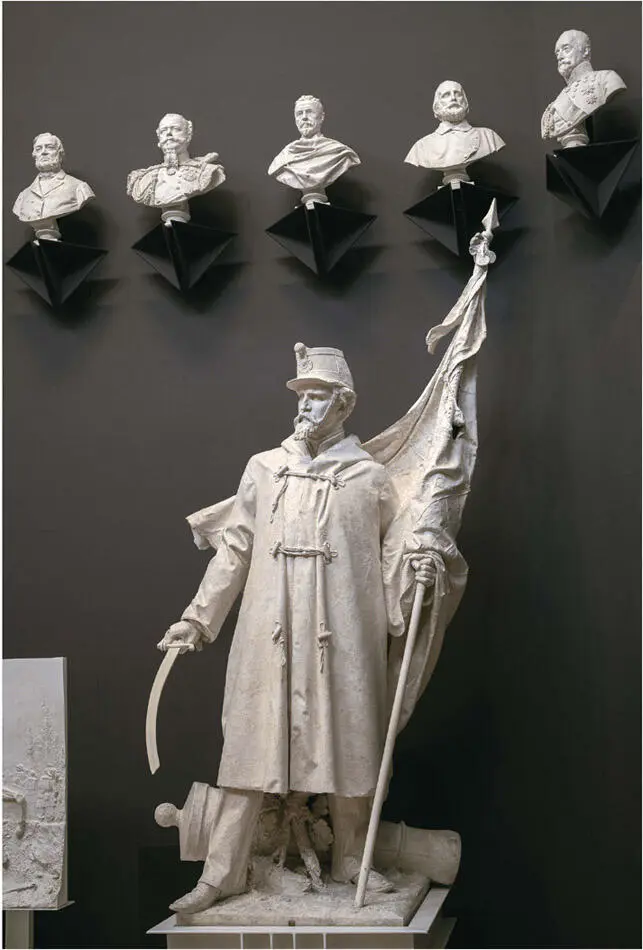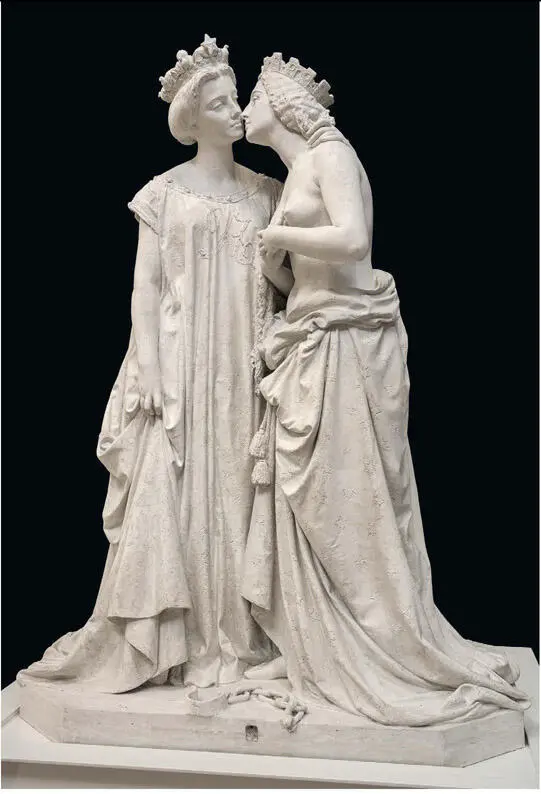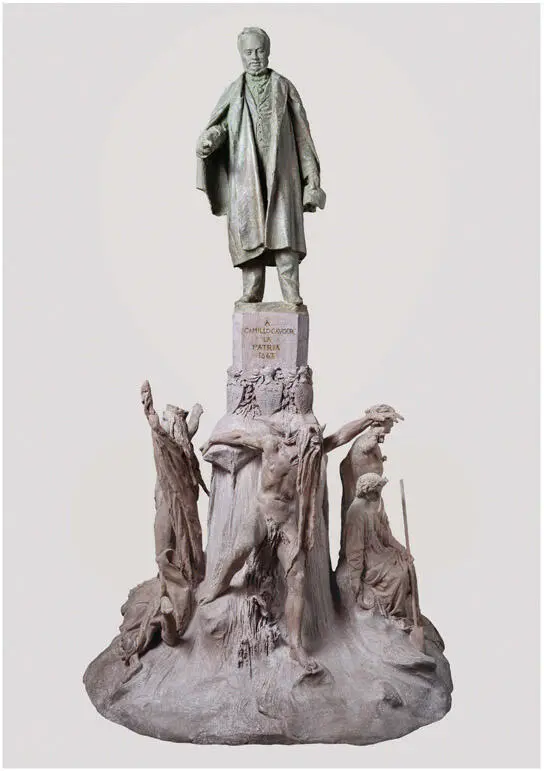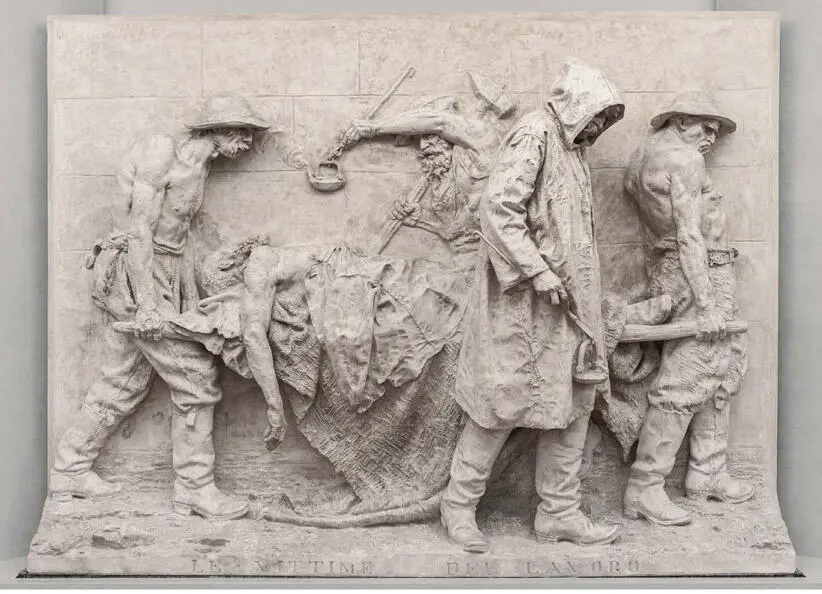International exhibitions and triumphs
The fame of the Swiss artist who had chosen to serve the Risorgimento spread abroad. Undoubtedly, this also served Cavour’s diplomatic interests. Vela became one of the new ‘Salon artists‘: his career no longer relied solely on commissions but was also driven by his skilfully managed participation in public exhibitions. Thus Italy Grateful to France ( I), a supremely eloquent allegory exhibited at the Paris Salon of 1863 and commissioned by a group of Milanese noblewomen as a symbolic gift for Empress Eugénie of France, earned him the title of Chevalier de la Légion d’honneur. The sculptor was also asked to portray Christopher Columbus for Emperor Maximilian of Mexico, the same year that Edouard Manet caused a scandal with Le Déjeuner sur l’Herbe ! The sculpture entitled The Last Moments of Napoleon I (1866, II, today in Versailles), a reflection on the rise and fall of the powerful with an intense emotional impact, also caused a sensation at the Exposition Universelle in Paris in 1867. Vela was awarded a first-class gold medal and promoted to Officier de la Légion d’honneur, while the work itself was purchased for a considerable sum by Napoleon III, nephew of the Emperor, who installed it opposite Sappho (1852), the statue of the Greek poetess executed by James Pradier, in the Palais de Saint-Cloud.
Managing studios and creating an art industry
Inundated with commissions, Vela had to adapt his productive capacities to the growing demand, which meant running three studios contemporaneously and employing many assistants and specialized pupils. The sculpture workshop rapidly became a profitable art factory with skilled workers, although the quality of the pieces sometimes suffered. He continued to execute small-scale models personally for use in negotiations with clients, but after casting the life-size clay models in plaster he left to his assistants the challenging task of transposing the model into marble and the polishing of the finished sculpture. He supervised the development of projects as creator, organizer and businessman, doing the manual work himself when it was a question of producing the much-admired surface effects: the public was easily won by his technical virtuosity.

Vincenzo Vela, The Flag-Bearer: Monument to the Sardinian Army , 1857–1859, plaster original.

Vincenzo Vela, Italy Grateful to France , A Gift from Milanese Ladies to the Empress Eugénie, 1861–1862, plaster original.
However, success did not enable him to understand that the political climate in his adopted country had changed: Vela’s being the favourite in the 1863 competition in Turin to execute a Monument to Camillo Benso, Count of Cavour ( IV) gave rise to a murky conspiracy, which ended with the sculptor’s abruptly abandoning the chair at the Academy. Being Swiss, after the unification of Italy he was made a foreigner who had to compete with local artists. In 1867, at the age of forty-seven, he bitterly withdrew to the place he had grown up in, where he had built a summer residence with a view to its becoming a museum for his work. However, he continued to be unanimously considered the founder of Italian verism: his admirers called him the ‘Cavour of art‘ (Carlo Pisani, 1870) and the ‘Ligornetto Phidias‘. During the last thirty years of his life he continued to work apace, accepting commissions for portraits and funerary monuments, and not unfrequently for representations of popular themes. Even when elderly, he could not resist projects of vast scope.
In 1873, Charles II, Duke of Brunswick, died in exile in Geneva. As an eminent Swiss sculptor, Vela was commissioned by the duke’s executors to create a Neo-Gothic mausoleum and, together with his friend, the Ticino architect Antonio Croci, he designed a model on the lines of the Scaliger Tombs in Verona ( IV). Work on the two life-size statues in plaster and the monumental Equestrian Statue ( I) were well underway when the two lawyers who had commissioned the piece requested some unwarranted changes, which turned out to be a mere pretext. Once again, Vela was the victim of shady machinations and, feeling that his creative freedom had been curbed, he rescinded the contract. The work, whose imposing scale would have made it a crowning achievement of his career, was completed in a relatively short time by other sculptors supervised by the architect Jean Franel and was unveiled on the Quai du Mont-Blanc in Geneva in 1879.

Unknown, Vincenzo Vela and His Coworkers (Turin) , 1855–1860 (1938), salt print based on the original photography.

Vincenzo Vela, Bozzetto of the Monument to Camillo Benso, Count of Cavour (first version), 1863, terracotta and patinated plaster.

Vincenzo Vela, The Victims of Labour , 1882, plaster original.
Although disillusioned and in bad health, Vela devoted himself to domestic politics. In 1877 he was elected to the radical group of the Grand Council of Ticino, where he campaigned strenuously in favour of the weak. Besides, he himself was an example of social emancipation: the son of farmers, he had risen to become a prince among artists, without ever hiding his humble origins.
His solidarity with the oppressed was conveyed in a late work, the manifesto of his ideals. Having been financially independent for some time, he could afford to realize his long-nurtured desire to design a monument to the unknown who had died during the construction of the St Gotthard tunnel, The Victims of Labour ( VII). In the history of art, this magnificent high relief is an unparalleled emblem of the industrial age. The plaster original – a posthumous version in bronze was ordered by the Galleria d’Arte Moderna in Rome while another copy was unveiled at the railway station of Airolo in 1932 – shows the miners consumed by fatigue as they carry away on a stretcher a dead co-worker, whose face is unmistakably that of the artist. This secular version of the Deposition, modelled with superlative technique, is the first ever monument dedicated to workers: a tribute to a class who previously had only had the honour of decorating, as underlings, the pedestals of monuments. This social realist model, which found its equivalent in the paintings of Gustave Courbet, was the main attraction at the first Swiss National Exposition in Zurich in 1883. Yet again Vela’s art became the means of presenting political issues – in this case those concerning the nascent workers’ movement – to a wide public.
Читать дальше

















